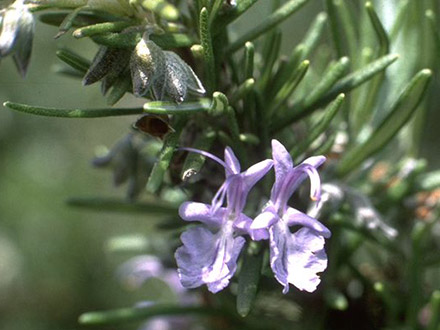Botanical name
Rosemary - Rosmarinus officinalis L.
Family
Labiatae (Lamiaceae)
Information about the plant
Rosemary is native throughout the Mediterranean up to Portugal. The name comes from the Latin "ros marinus", which means "dew of the sea," although it is not clear how it arrives at this description. The epithet officinalis suggests that it is an ancient medicinal plant, the "officina" is the sales room of a pharmacy. The fragrant shrub of rosemary grows up to 1 metre high. The hard, narrow-lineal leaves that look like needles with white-tomentose hairs underneath are very characteristic. When rubbed they smell pleasantly of the essential oil. It is in the glandular scales on the leaf surface and as they are broken the essential oil is released. There are pale blue to mauve lip flowers in the leaf axils. Flowering time is May to June.
Medicinally used parts of plants (herbal drug)
The dried leaves are used with their typical scent of rosemary, which is clearly perceived when rubbed. The commercially available drug comes from imports from Spain, Morocco, Tunisia and South Eastern Europe.
Constituents of the herbal drug
Rosemary leaves contain essential oil ("rosemary oil"), with its aromatic scent made of 1.8-cineole, camphor, pinene and other monoterpenes plus bitter terpenphenolics and Lamiaceae tannins (mainly rosmarinic acid).
Quality of the drug
The quality of the following drugs or drug preparations is specified in the European Pharmacopoeia (Ph. Eur):
- Rosemary leaves (Rosmarini folium)
- Rosemary oil (Rosmarini aetheroleum)
Medical applications
Recognised medical use
Rosemary leaves
Internally for dyspepsia; externally as supportive therapy for rheumatic diseases, circulatory problems (Commission E) to improve the liver and gallbladder function and for dyspeptic complaints; externally as supportive therapy for rheumatic diseases and circulatory disorders as well as a mild antiseptic to promote the healing of wounds (ESCOP). The HMPC has classified rosemary leaves and rosemary oil as a traditional herbal medicinal product (see "traditional use").
Traditional use
The HMPC has categorised rosemary leaves and rosemary oil as a traditional herbal medicinal product (§ 39a AMG). Based on many years of experience, rosemary leaves and rosemary oil can be used internally for dyspeptic complaints and to relieve slight spasmodic gastrointestinal complaints. External use, either as a bath additive (rosemary leaves/rosemary oil) or as an application (rosemary oil) to support the easing of mild muscle and joint pain, as well as circulatory problems. Rosemary leaves are applied externally to support the skin blood flow, in combination with other substances (such as camphor, menthol, lavender) to support cardiovascular function (traditional use acc. to § 109a).
Herbal drug preparations in finished dosage forms
- Rosemary leaves as an ingredient in cardiovascular teas
- Rosemary oil in ointments, creams, bath oils (rheumatism ointment, ointment heart, rheuma-baths, cardiovascular-baths)
Dosage
Prepared drugs: see package insert;
Tea infusion: average daily dose of 4-6 g of rosemary leaves, rosemary oil: apply in 6 to 10% preparation as an ointment or lotion 2 times daily;
bath additive: 2 times a week as a full bath. Pour boiling water over 2 cups of finely chopped rosemary leaves and leave for 15 minutes then drain. Use as a bath additive, mix 50g of rosemary leaves with 1 L of water and boil briefly. After 15 to 30 minutes pour it through a sieve and add the liquid extract to the bath water.
Notes
Only take rosemary leaves and rosemary oil under medical supervision if you have biliary symptoms (biliary stone disease, occlusion of bile ducts, gall bladder, etc.) and a liver disorder. Full baths with rosemary leaves and rosemary oil should be avoided if you have large open wounds and skin lesions, a fever, severe infections, severe vascular disease and heart failure. Do not apply rosemary as an external application directly to the mucous membranes or broken skin, and never around the eyes.
There are still no studies on the safety of taking rosemary leaves during pregnancy and breast-feeding as well as for use in young people under 12 years old.
Side effects
At most allergies
Interactions
None known
References
Herbal drug monographs
Further literature
Wichtl: Teedrogen und Phytopharmaka, pg. 573
Schilcher: Leitfaden Phytotherapie, pg. 222
Van Wyk: Handbuch der Arzneipflanzen, pg. 276
Kommentar zum Europäischen Arzneibuch (Rosemary leaves, no. 1560; Rosemary oil, no. 1846)


